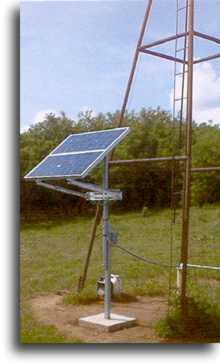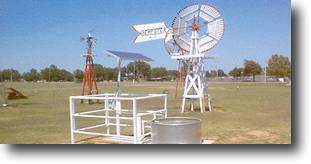
1. Where do solar pumping systems work?
Solar pumping systems work anywhere the sun shines. The majority of the continental U.S. enjoys plenty of sun to operate a pumping system economically. The intensity of light varies greatly throughout the day. Morning and afternoon sunlight is less intense because it is entering the earth's atmosphere at a high angle and passing through a greater cross section of atmosphere, which reflects and absorbs a portion of the light.
We measure sun intensity in equivalent full sun hours. One hour of full sun is roughly equivalent to the sunlight on a clear summer day at noon.
These light or isolation levels also vary seasonally. Fortunately, most needs for water correspond with the sunniest seasons of the year - spring, summer and fall. One of the advantages of providing additional sources of water for livestock use is increased forage utilization. On large tracts some areas are not fully utilized because they are too far from water. As you know, livestock will only travel so far between feed and water.
Small to medium solar electric pumping systems are easily portable. By mounting the solar system on an axle or trailer, a system can be moved from well to well. This increases the economic return of a system by increasing the seasons of use. It may also correspond with the rotation of grazing areas.
2. Economics of Solar Water Pumping
The economy and reliability of solar electric power make it an excellent choice for remote water pumping. Cattle ranchers in the Western US, Canada, Mexico, and Australia are enthusiastic solar pump users. Their water sources are spread over many miles of rangeland where power lines are few and refueling and maintenance costs are substantial.
If your water source is 1/3 mile or more from the powerline, solar is a favorable economic choice. This fact is reinforced by a number of Rural Electric Cooperatives across the US. These Co-ops actively advocate the use of solar pumps, as the cost to extend new lines is subsidized by other rate payers.
A solar pump minimizes future costs and uncertainties. The fuel is free. Moving parts are reduced to as few as one. A few spare parts can assure you many years of reliable water supply at near-zero operating costs.
3. Fixed VS. Tracking Mount Structure
Fixed Mount structures are less expensive and tolerate higher wind loading. By fixing the modules due south, less water is pumped than a tracking system which orients the modules towards the sun as it arcs across the southern sky.
Tracking mount structures keep the modules at a 90 degree angle to the sun all day long. This provides more power to the pump over a longer period of the day, which produces 20 to 40 percent more water daily in the summertime. A solar pump minimizes future costs and uncertainties. The fuel is free. Moving parts are reduced to as few as one. A few spare parts can assure you may years of reliable water supply at near-zero operating costs.
 4. Windmills: Yesterday's Answer to Remote Water Delivery
4. Windmills: Yesterday's Answer to Remote Water Delivery
There are still thousands of windmill water pumping units standing in the Western US. Regrettably, many are inoperable. These pumpers were very valuable for remote (off grid) sites, with the proper minimum wind conditions, when manpower was plentiful and cheap. Windmills, though potentially long lasting, need dedicated maintenance. The down hole leathers require inspection and high winds can cause mechanical damage to the blades. Parts for these mills are expensive and sometimes hard to find.
Solar water pumping systems have many advantages over windmill water pumpers. Though the initial cost of solar powered systems can be similar to that of windmill (however, in many cases far less) the life time costs are much lower. Windmills must be used where there is a steady, constant wind for maximum results while solar pumps operate anywhere the sun shines. Solar pumping systems can be installed in less than a day by an individual or small crew and can be portable, while windmills (because of the need to erect a tower) can take a larger crew a much longer time to install. Windmills are secured to the ground and are stationary. Solar powered water pumping systems are the modern day upgraded version of the windmill which uses natural resources to deliver water in off grid locations.
5. Rancher Concerns
Because of the low cattle prices of today, the cost of water is a prime concern for a rancher. Every dollar wasted on an inefficient water system is a dollar of , profit out of the rancher's pocket. When faced with a need for a new water system or to repair an old system the natural thought is to look at the lowest initial cost. But the lowest initial cost may not be the most cost effective. A smart rancher will not only look at the initial cost but will also consider the long term cost along with the reliability. If he is interested in higher profits he should take a look at his present water costs. He should then compare these costs to several alternative methods to determine the most cost effective one.
6. Sizing a Solar Water Pumping System
(download or print sizing information)
When sizing a solar water pumping system, there are many variables to take into consideration. Most important of these are the following: Identify how much water is needed per day. This variable may given in (GPD) gallons per day or (LPD) liters per day. In most situations it is common practice that systems provide optimally three days of water storage. The reason for this is to have enough stored water in case of cloudy conditions which may exist for more than 1 or 2 days. Weather can play a crucial role in determining the output of your application. Finally, it is important to know the distance from the pumping level to the top of the tank or discharge point. This pumping level is referred to as the static water level or standing water level in the well when the pump is not running.

